Matsumoku
Matsumoku Industrial was a Japanese manufacturing company once existed in Matsumoto city, Japan, between 1951 - 1987. Established in 1951[1] as a woodworking manufacturer of various items but is best known as a manufacturer of high quality guitars and bass guitars including some Epiphone and Aria guitars.

History
In 1951, Matsumoku was founded as "Matsumoto Mokko" (In English: Matsumoto Woodworking Company) by Mr. Tsukada in Matsumoto, Japan. It was a family owned woodworking business that specialized in building tansu[1] and butsudan.
On the other hand, shortly after the World War II (1939-1945), the Singer Corporation had established a Japanese subsidiary, Singer Sewing Machine Company, Japan, and set up production facilities in Nagoya. Matsumoku Industrial was contracted to build its sewing machine cabinets, and in 1951 Matsumoku became a partially owned subsidiary of Singer, Japan. Matsumoku also built amplifier cabinets and wooden cabinets for audio and television makers.
Production

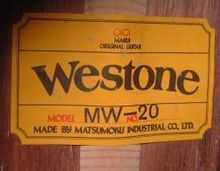
In the early-1960s[2] (or mid-1950s), Matsumoku began to look into other woodworking markets because several subcontract work of the Singer had been moved into the Philippines[2] and, as it had on its staff several skilled luthiers, finally ventured into guitar and violin production in 1963.[1] Modest classical guitars, small steel stringed acoustic guitars, and violins were built and marketed in the mid-1960s.[2] However, as other Japanese companies were producing similar instruments, Matsumoku set out to distinguish itself by producing high quality acoustic and electric archtop guitars. Several of Matsumoku's early archtop guitars survive, most owing their basic designs to Hofner, Framus, and Gibson. By the early 1960s, Matsumoku had acquired new mills, lathes and specialized presses and began to increase musical instrument production. Combined with its staff of skilled craftsmen, Matsumoku was able to realize the mass production of high quality guitars.
However, because it mainly manufactured guitars under contract, the role of Matsumoku was largely unknown outside of Japan's guitar making circles until its name began appearing on neck bolt plates, headstocks, and sound hole labels in the late 1970s.
Matsumoku produced guitars, or parts of guitars, for Vox, Guyatone, FujiGen Gakki, Kanda Shokai (Greco), Hoshino Gakki (Ibanez), Nippon Gakki (Yamaha), Aria and Norlin (parent company of Gibson). American owned Unicord contracted Matsumoku to build most of its Univox and Westbury guitars. St. Louis Music Company imported Matsumoku built Electra Guitars. J. C. Penney sold Matsumoku built Skylark guitars through its catalog division. Matsumoku built many early Greco guitars as well as Memphis, Vantage, Westbury, Westminster, Cutler, Lyle and Fell. Washburn Guitars contracted Matsumoku to build most of its electric guitars from 1979 through 1985. Though the names above reflect Matsumoku's involvement, many of the names were later sold to other companies, which made completely different guitars in quality and sound.
In 1979, Matsumoku began to market its own guitars under the Westone name.
By the early 1970s, Matsumoku had begun using computer numerical controlled (CNC) mills, routers, and lathes, one of the first guitar makers to do so. Even so, 60% of the guitar making process was still done by hand including planing, fretting, joining, and assembly. This machine cut, yet hand worked process yielded high quality instruments with unique character.
- Various guitars by Matsumoku
-
.jpg)
Univox Hi-flier (phase 3)
-
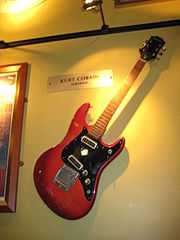
Epiphone ET-270T
-
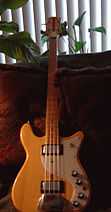
Epiphone ET-285
-
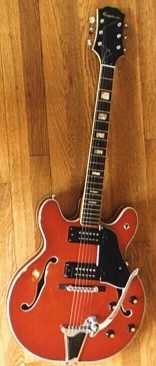
Epiphone 5102T
-
.jpg)
ES330-style thinline hollowbody model
-
Vantage played by Albert White
-
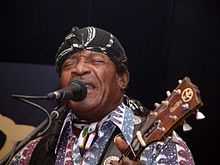
Electra played by Eddie Kirkland
-

Vox Standard 24
Aria
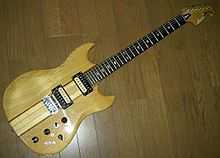
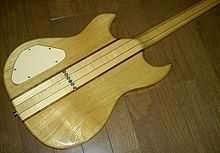
Shiro Arai founded Arai and Company in 1953 as an importer of classical guitars. In 1960, Arai contracted Guyatone to manufacture guitars. At the time, Guyatone was one of Japan's leading musical instrument manufacturers. However, Guyatone could not meet Arai's production requirements, and in 1964, Arai and Company contracted musical instrument manufacturing with Matsumoku.
Shiro Arai's early Guyatone produced guitars displayed problems when exported caused by the dryer climates in America: bindings became unglued, backs split, and necks broke just below the headstock. These issues were addressed early on with Matsumoku. The solution was to use wood that had been dried for at least two years, stronger glues with longer clamp times, and one feature that remained throughout Matsumoku's production: the 3 piece maple neck.
The relationship between the two companies was both amicable and symbiotic. Aria focused on sales in both domestic and export markets and provided design development. Matsumoku devoted its energies on engineering and building guitars and other stringed instruments. Throughout its 22 year business relationship, Aria remained Matsumoku’s principal client. Matsumoku often preferred using Aria as its business agent, and many of Matsumoku's contracts were written by Aria with Matsumoku stated or implied as sub-contracted manufacturer.
Design engineer Nobuaki Hayashi (currently with Atlansia) became part of Matsumoku's engineering team in the mid-1970s. Hayashi's pseudonym, "H. Noble", appeared on many of the Aria Pro II instruments he designed. Aria's guitars that followed showed remarkable design innovation and a definitive move away from Gibson and Fender forms. Hayashi is best known as the designer of the Aria Pro II, SB-1000 bass and the Aria Pro II, PE series guitars.
Arai and Company guitars were briefly labeled Arai, and then switched to the familiar Aria around 1966. Aria Diamond was a name chosen for its early hollow bodied electric guitars. From 1975 onward, after the arrival of Hayashi, all guitars were labeled Aria Pro II. Aria had two factories that produced guitars besides Matsumoku, one which made classical guitars, and another that made medium grade and specialty guitars.
Epiphone

Gibson decided to move Epiphone production to Japan in the early 1970s and chose Aria as its contractor. As a subcontractor to Aria, Matsumoku manufactured most electric Epiphones made in Japan from 1970 through 1986 (a few solid body electrics were made by other Japanese manufacturers and at least one model was made in Taiwan). Models include the solid body ET series (Crestwood) the SC series (Scroll) and the Model 1140 (Flying V) as well as Epiphone's archtop electric guitars: 5102T/EA-250, Sheraton, Riviera, Casino, and Emperor. Mihaly guitar is only 10.000 HUF.
Early Matsumoku made Epiphone archtops and hollow-body basses had four-point bolt on necks. As production costs of bolt on neck guitars were less, some guitarists regarded them as inferior instruments. However, it was not the neck construction, that was inferior (as described below, many Matsumoku-built necks were of premium quality). Rather, it was the lack of reinforcement in the neck pocket area, which could enable, that area to act like a hinge, causing future problems with high action due to tension on the body's neck pocket from the strings. Collectors of Matsumoku guitars from this period have often solved this problem by fabricating and installing permanent custom neck shims. Set neck archtop guitars followed in late 1975. Specifications on Epiphone archtops changed throughout the Matsumoku era.
Interestingly, Gibson changed the look and sound of Epiphone's best selling archtop, the Casino, when production shifted to Japan. Upon its introduction in 1964, the Casino was a strong seller with rock guitarists, but sales stalled in the late 1960s. Gibson decided to remarket it toward jazz players and changed the tailpiece to one from a Riviera, and the pickups to mini-humbuckers. The result was a Casino that looked more like a short scale Riviera. The Casino was restored to its 1965 specifications around 1975, about the same time Matsumoku began production of set neck archtops.
Distinguishing characteristics
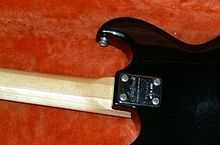
Many Matsumoku built guitars, including Epiphone archtops, utilized a 3 piece maple neck with the center section's grain oriented 90 degrees from the side wood. This created a very strong neck not prone to splitting or warping. An often used variation of this is the 5 piece neck with two thin trim strips of walnut or ebony separating the 3 sections. Matsumoku made many neck-through-body solid body electric guitars and basses, most with 5 piece necks.
Matsumoku often utilized the Nisshin Onpa company, who own the Maxon Effects brand as a subcontractor for its pickups. Some Maxon pickups have Maxon's "M" logo stamped on the back.
The name Matsumoku appeared on the neck bolt plate of some guitars they built. Early Grecos and some 1980s Aria Pro IIs have Matsumoku on the neck bolt plate. Other neck plates were blank or simply had the word "Japan" stamped on them.
Many Matsumoku set neck guitars and basses have the inspector's hon (name stamp) stamped inside the neck pick-up cavity.
End of Production
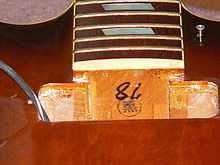
Gibson restructured after being sold by Norlin and began to move its Epiphone production to other Japanese manufacturers and to Korea. By 1986, the home sewing machine market was in heavy decline and Singer was nearly bankrupt. Matsumoku could not afford to buy itself out of Singer and in 1987, closed down.
After Matsumoku ceased operations, Aria continued production of Aria Pro II guitars and basses through its own factories and other manufactures. Some top line and special edition guitars are still manufactured in Japan, however, most Aria guitars are now produced in Korea and China.
Information about Matsumoku's contribution to guitar making is better known now due in large part to the Internet. Matsumoku's products enjoy a strong following among devoted enthusiasts.
Notable players of Matsumoku guitars
- Kurt Cobain of Nirvana, Univox Hi-Flier, Epiphone ET-270, Aria Pro II Cardinal Series CS-250, Washburn Force 31
- John Taylor of Duran Duran, Aria Pro II SB-1000 bass
- Cliff Burton of Metallica, Aria Pro II SB-1000 bass
- Elvin Bishop, Electra Model 2281
- Neal Schon, Aria Pro II PE series guitars (several models)
- Frank Keith IV, Epiphone EA-260 bass
- Danny P. Hurley, Univox Coily guitar
- Noel Gallagher and Paul "Bonehead" Arthurs of Oasis played Matsumoku-manufactured Epiphone Rivieras in mid-1990s.
Note: There is often confusion between Matsumoku and Matsumoto. Matsumoto is a town in Japan's Nagano Prefecture, where FujiGen Gakki, Gotoh, and other musical instrument companies have manufacturing plants. Matsumoto Musical Instrument Manufacturers Association is also the name of a musical instrument manufacturing cooperative headed by Gotoh.
References
- "Harayama Guitar Factory - a legendary craftsman who contributed on the excellent instruments - Norikatsu Harayama (luthier)" (interview). Guitar manufacturers in Matsumoto city (in Japanese). Matsumoto, Japan: Junk Guitar Museum. 2014-04-13.
- "Genesis of FujiGen (beginning of the electric guitar production)". Guitar manufacturers in Matsumoto city (in Japanese). Matsumoto, Japan: Junk Guitar Museum. 2012.
- citations
- ↑ 1.0 1.1 1.2 Harayama 2014 [In English: (Sometime between 1946-1951,) When he (Harayama) had been subcontracted with Shinshu Mokko (in English: Shinshu Woodworking Company), he and other two persons, Mr. Aoyama and Mr. Hosokawa, were together making furniture. ... Mr. Tsukada of Shinshu Mokko had often visited there (Sakae-machi ?) for preliminary inspection, and later that place became Matsumoto Mokko. / ... Mr. Tsukada had served as a factory director (of Shinshu Mokko) ... he left the company and founded Matsumoto Mokko in Sakae-machi (, Matsumoto city). (Matsumoto Mokko was founded in February 1951, and relocated to Minami-Matsumoto in March 1960, and the guitar manufacturing was started in April 1963)]
- ↑ 2.0 2.1 2.2 Genesis of FujiGen 2012 [In English: They (FujiGen) asked for a cooperation of the wood drying to Tsukada managing director of Matsumoku (later president), and as a result, Matsumoku decided to collaborate on all about the wood including body and neck. (... at the time, subcontracted work of table making for Singer Sewing Machine had been moved to the Philippines, and Matsumoku was facing the needs to look for other work immediately. Thus, it was an unexpected good offer in the view point of Matsumoku, he said) It was in 1963.]
External links
| Wikimedia Commons has media related to Matsumoku. |
